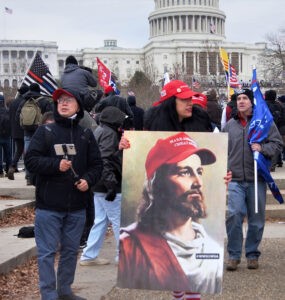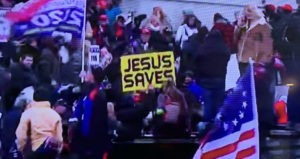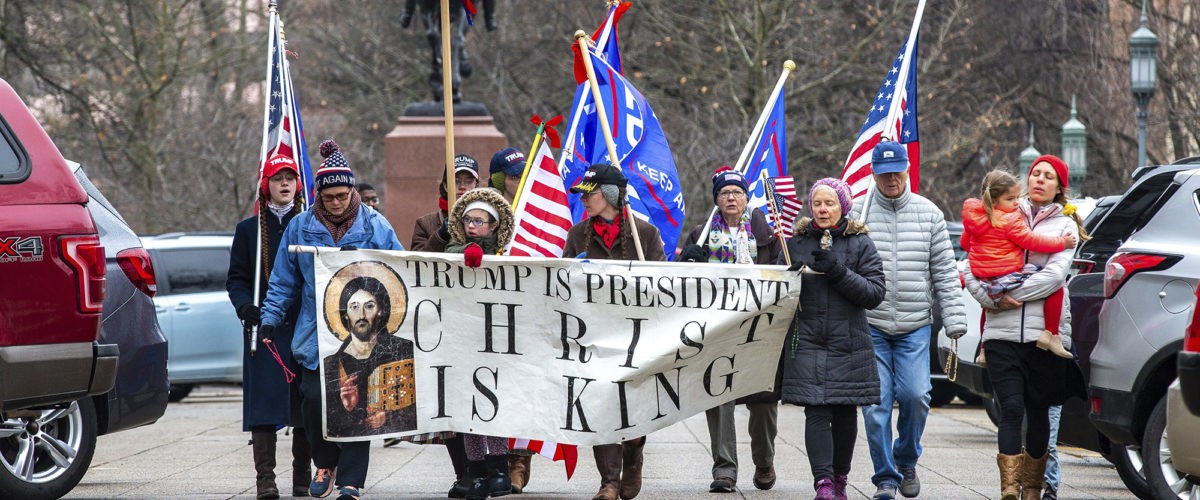A new online resource documents the religious components of the Jan. 6, 2021, insurrection at the United States Capitol.
Uncivil Religion: January 6, 2021 is a collaboration of the University of Alabama’s Department of Religious Studies and the Smithsonian’s National Museum of American History.
“Religious symbols, rituals, identities, banners, signs and sounds suffused the events surrounding the U.S. Capitol on January 6, 2021. This project begins to trace the thread of religion that wound throughout that day through pieces of digital media,” an introduction to the site explains.
 The site includes a collection of essays that analyze individual pieces of media from that day — from tweets to video to photographs — plus a series of galleries that show those media.
The site includes a collection of essays that analyze individual pieces of media from that day — from tweets to video to photographs — plus a series of galleries that show those media.
While not an exhaustive catalogue of the intersection of religion and the day’s events, the site does offer a well-researched sampling of the many ways religious ideas both motivated the protesters and were expressed by them.
Media included address both the “Stop the Steal” rally that began the day as well as the march to the Capitol and the violent assault that happened there as supporters of then-President Donald Trump sought to invade the building and physically stop the counting of Electoral College ballots that would give the presidency to Joe Biden.
The site’s creators describe it as “a resource for anyone, from the general public to other scholars, interested in tracing the variety of ways religious identities, ideas, symbols and rituals intersected with the events of January 6.”
Four days after the fateful events, Peter Manseau, curator of religion at the National Museum of American History, began to point out the religious imagery on display under the Twitter hashtag #CapitolSiegeReligion.
“I’m convinced it is *the* story of what happened,” he tweeted a few days later. “Not everyone wore a Guns & God hoodie or carried a Jesus flag but they all shared the psychological safety net such symbols provided.”
Other scholars, journalists and observers began to notice this trend as more video and photographs of the day circulated. Then #CapitolSiegeReligion became a tool for Twitter users to share such material. That, in turn, led to a virtual event produced by the American Academy of Religion.
Hundreds of articles have since been published on the relation between religious belief and the insurrection. Baptist News Global has published at least 30 articles on this subject over the past year.

Screenshot of a scene from the U.S. Capitol riots on Jan. 6, 2021.
“We contend that religion was not just one aspect of the attack on the Capitol, but, rather, it was a thread that weaves through the entirety of the events of Jan. 6,” the site’s creators explain in an introductory section to the resource. “Our researchers sorted through thousands of items, many posted on social media platforms on Jan. 6, 2021, or soon thereafter, to gather, identify and catalog media. Our effort to locate items relating to religion and Jan. 6 is ongoing. … The media we have identified not only illustrate that religion was central to the Jan. 6 events but also indicate the diversity (and perplexities) of American religion and its relations with American political activity and history.”
The resources and media are sorted into three categories: Christian nationalism, religious plurality, and connections that might not at first appear to be religious but actually are religious, labeled as “religion behind the events.”
Scholars who contributed essays include Philip Gorski of Yale University, Kristin Du Mez of Calvin College, Peter Manseu of the National Museum of American History, Matthew Gabriele of Virginia Tech University, Theodore Louis Trost of the University of Alabama, Sarah Imhoff of Indiana University, Benjamin Park of Sam Houston State University, Melissa Mathes of the U.S. Coast Guard Academy, Lauren Horn Griffin of the University of Alabama, Dana Lloyd of Villanova University, Danielle Boaz of the University of North Carolina at Charlotte, Leslie Dorrough Smith of Avila University, Matt Sheedy of the University of Bonn in Germany, Anthea Butler of the University of Pennsylvania, Jamil Drake of Florida State University, Cody Musselman, and Samhah Choudhury of Ithaca College.
The project is directed by Michael Altman, associate professor in the department of religious studies at the University of Alabama and Jerome Copulsky, consulting scholar at the National Museum of American History’s Center for the Understanding of Religion in American History. Peter Manseau serves as project advisor.
The project was supported by a grant from the Henry Luce Foundation.
Related articles:
Trying to make sense of January 6: Jesus wept | Opinion by Alan Bean
Pastors respond to unbelievable events at Capitol on Epiphany 2021
Christian symbols and sedition at the Capitol: The church has work to do | Opinion by Rhonda Abbott Blevins
We knew there would be a reckoning for religious leaders enabling Trumpism, we just didn’t know it would be today | Opinion by Mark Wingfield
More advocates needed to counter Christian nationalism, BJC leader urges


